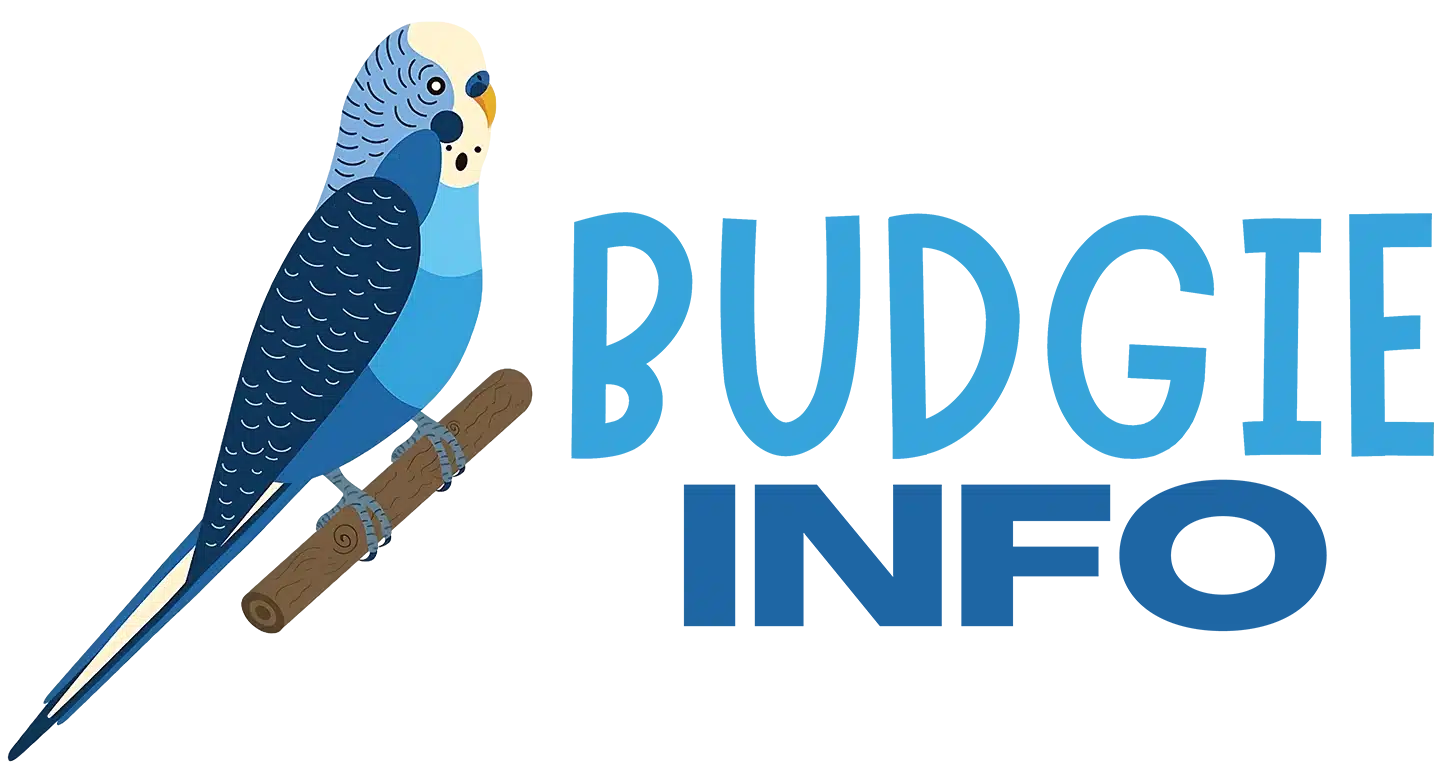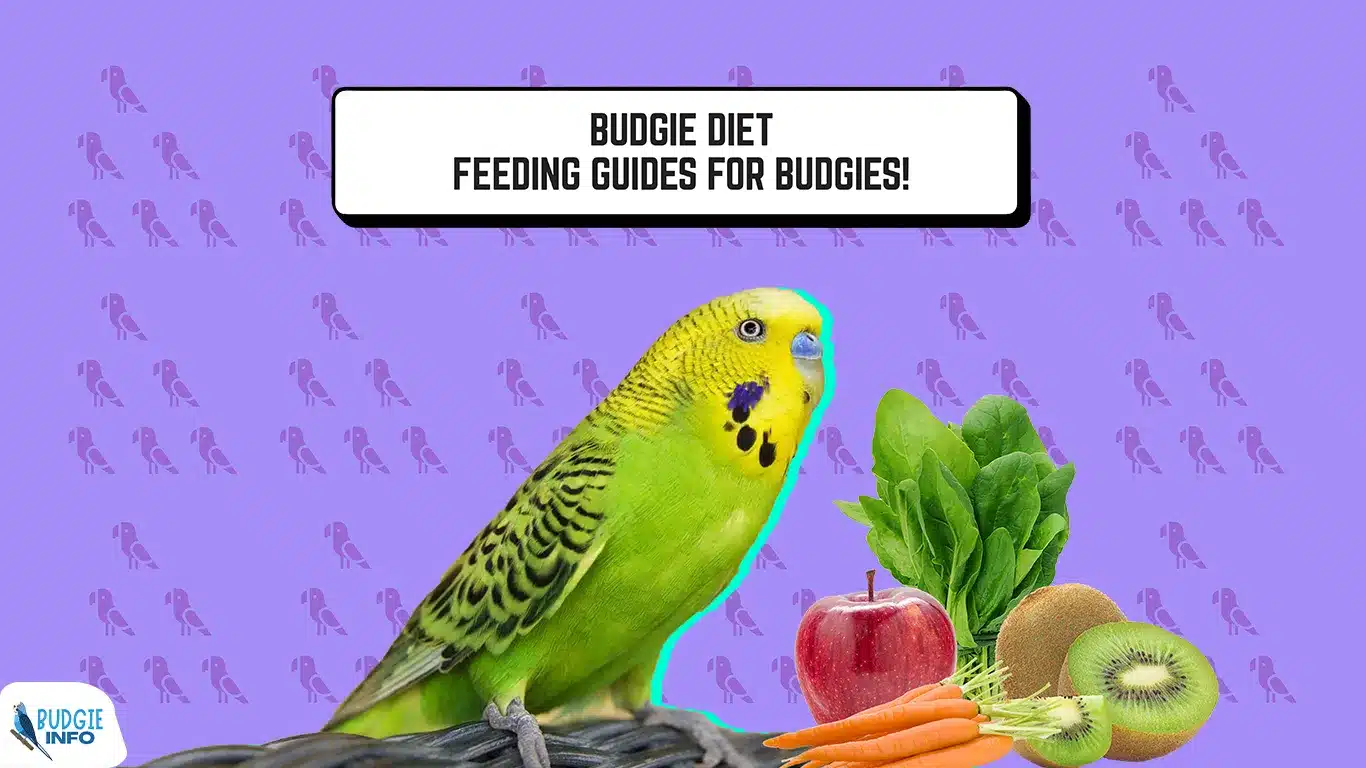Learning about the budgie diet can be tricky but interesting, just like budgies. Here’s a complete guide for what to feed your budgie to keep them healthy and live longer.
So let’s dive right in.
What Do Budgies Eat in the Wild?
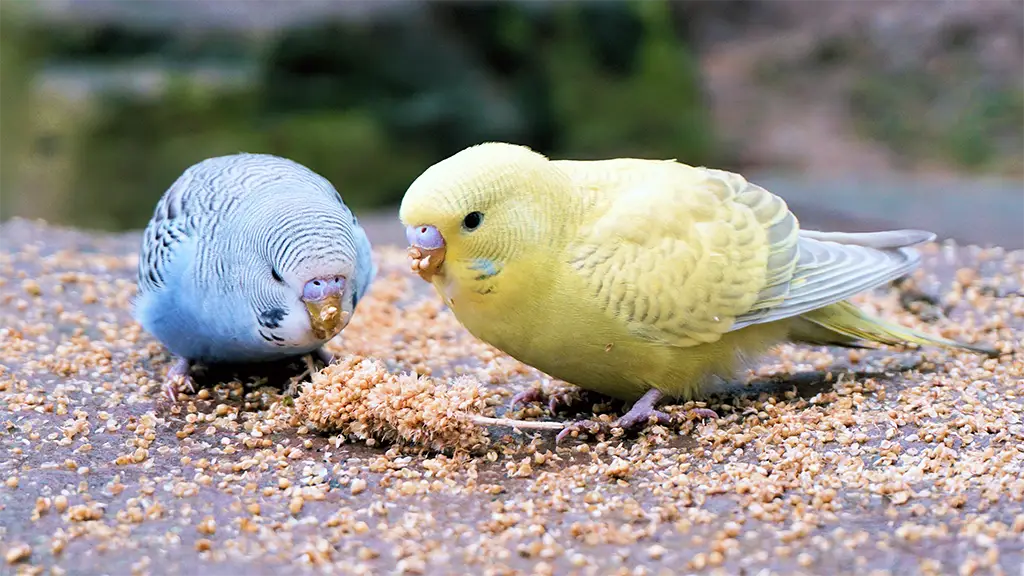
The natural diet of budgies in their native Australian habitat includes seeds, grains, and nuts. Budgies across borders follow the same food habits.
Budgies mostly eat food from the ground. They’re often seen picking up seeds and grains from the grass. Interestingly, budgies are masters at dehusking seeds and swallowing them. Their diet includes more seeds and grains, so they are often tagged as granivores.
However, greens take up a considerable portion of the budgie meal besides grains. These birds munch on Banksia, Mallees, Eucalyptus, Acacia, and other plants in the wild.
A wild diet of budgies includes the following items:
| Grains and Herb Seeds | Grass Seeds | Greens | Fruits | Insects |
| Wheat, Buckwheat, Barley, Quinoa, Rye, Clover, Fennel, Sweet kernel, Chia, Oat, etc, | Alfalfa grass, Meadow grass, Orchard grass, Timothy grass, Velvet grass, etc. | Bottlebrush, Eucalyptus, Hakia, Spinach, Parsley, Spider plant, Parlor palm, Cabbage, Cauliflower, Basil, etc. | Berry, Peach, Banana, Kiwi, Mango, etc. | Ants, Midges, Flies, Worms, etc. |
The captive diet of budgies does not vary much from the natural meals. However, many budgie keepers usually do not go for a seed diet as it can be unhealthy for them which is said by most avian veterinarians. Hence, they mostly depend on organic pellets.
Similarly, many owners are not fans of feeding their birds live insects. Thus, they buy dried worms as a protein shot for their pets.
Finally, keepers mix supplements to the budgie meals in captivity to back up any mineral deficiency. In the wild, these birds collect all nutrients naturally from the surroundings.
Why Is a Balanced Diet Important for Budgies?
A balanced diet plays a huge significance in maintaining good health in budgies. The key reasons why we appreciate such a diet are,
- A balanced diet provides the budgies with all the essential nutrients (carbs, proteins, fats, vitamins, and minerals) needed to build a solid body. Thanks to the proper nutrition. Budgies can enjoy healthy digestion and optimal growth.
- Minerals and vitamins obtained from a balanced diet boost the immunity system of the birds. As a result, the pets stay more active now.
- A balanced diet has a direct influence on feather health. Only with proper food habits can budgies enjoy vibrant and strong feathers. A full feather elevates the overall appearance of the birdies and keeps them mentally relaxed.
But what happens if we refuse to feed the budgies healthy food? Well, the consequences are dreadful. Look at the potential risks associated with an unbalanced diet are,
- Obesity: An all-seed/pellet diet is high in sugar and fat. Spoiling your budgies with such meals will lead to obesity, raising the risk of a health disease.
- Vitamin Deficiency: A fiber-free meal often causes malnutrition in the budgies. It lowers their immunity, making them vulnerable to deadly diseases. Besides, the lack of nutrition contributes to weak bones and fragility.
- Feather Problems: Budgies can never enjoy a fluffy feather without a balanced meal. They will suffer from skin irritation, feather fall-out, less insulation, etc.
So, considering the risks that I mentioned, it’s smarter to ensure your feathery friend has a balanced diet.
What Nutrients Do Budgies Need?
According to Budgerigar Council South Australia, these bird meals must include high protein, low fat, vitamins, and minerals. Important nutrients for budgies are vitamins (A, B, C, D, E, and K), fiber, potassium, calcium, and antioxidants.
Luckily, they can get all these elements from a balanced diet. For example, the seeds and grains fulfill the protein and fat requirements. Similarly, vegetables and fruits take care of the vitamins, fibers, and other minerals. If something is still missing, the added supplement will fill the gap.
What Do Budgies Eat?
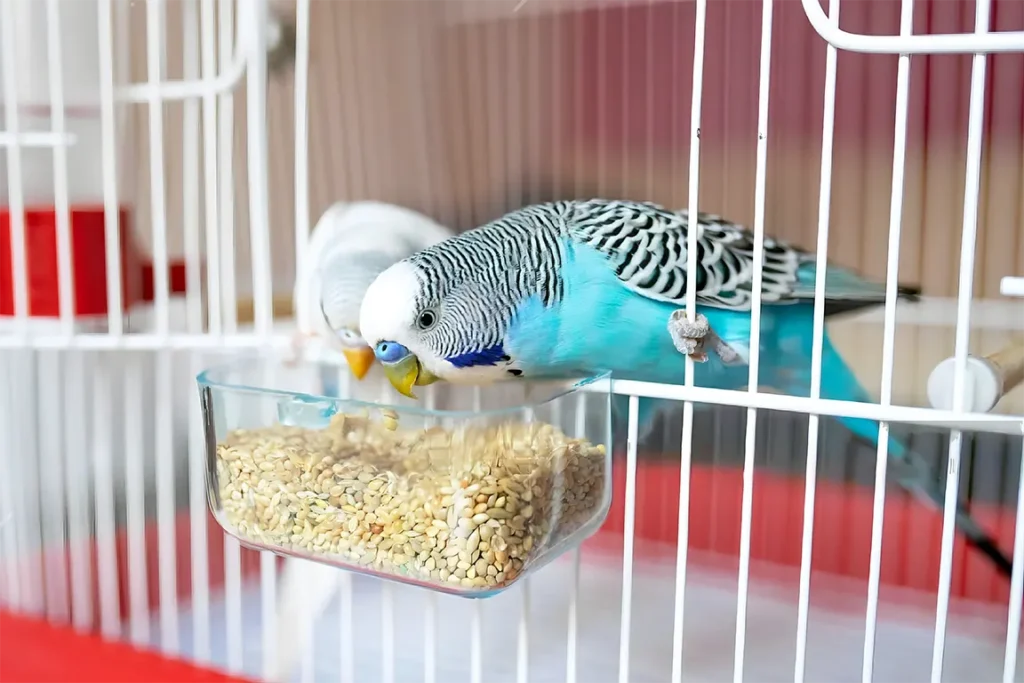
Though budgies are granivores, you can not entirely rely on seeds and grains. Surely, these grains and seeds have some essential fats and provide the birds with energy. Specifically, sprout seeds are a healthier option.
However, a sole-seed or grain diet can lead to malnutrition as it includes low protein and misses out on over 30 nutrients. The Unusual Pet Vets reports that a high-seed diet increases the risk of obesity, lump formation, and cardiovascular diseases in the budgies.
In fact, feeding the budgies just one type of seed is also harmful. In such cases, the birds will receive only certain minerals. Hence, to me, a seed mix sounds like a better option.
The seed mixes available in the market include 2 to 8 different seeds. These are more nutritious, yet not sufficient. Then what should you add to the budgie’s diet chart?
Here, have a look at the meal plan of my budgies.
High-Quality Pellets
Maximum owners including me, feed their budgies high-quality pellets as a complete nutrition package. Pellets are commercially made with organic elements. So, manufacturers can deliberately add certain minerals to the pellets, making them healthy. Pellets with different formulations are available for managing specific diseases, too.
You should include 30% to 50% high-quality pellets of the budgie’s diet. But how can you serve? Here are some tips for offering pellets to the birds are,
- Serve the seeds unmixed.
- You can offer your birds a seed and pellet mix only if your birds depend on seeds. However, gradually decrease the seed portion from the meal.
- You can ground the pellets and sprinkle them over the veggies and other moist food.
Fruits, Vegetables & Leafy Greens
Leafy greens, vegetables, and fruits contain all the essential vitamins, fibers, and minerals that budgies require to thrive. Hence, these items should account for 30% to 45% of their diet. The safe green, vegetable, and fruit options are,
- Veggies: Broccoli, capsicum, chili, corn, green beans, carrot, zucchini, squash, cauliflower, spinach, pumpkin, sweet potato, peas, etc.
- Green Leaves: Spinach, kale, parsley, mint leaves, turnip green, mustard green, endive, romaine lettuce, etc.
- Fruits: Bananas, strawberries, mango, watermelon, resin, apple, pears, kiwi, grapes, peaches, etc.
It is mandatory to wash the green leaves and fruits to remove any chemical residuals before giving them to your birds. Cutting the fruits, veggies, and greens into small, manageable portions makes them more snackable.
Fresh Water
People often debate over the best water source for the budgies. Frankly speaking, both filtered and tap water are safe for the birds if they are safe for humans. You can test the water condition in your locality to make the final decision.
Remember, making the budgies drink foul water can upset their stomach and cause them sickness. So always give them fresh water and make sure it’s easily accessible for them.
Occasional Treats
Budgies love treats. Experts suggest adding 1% – 5% treats to the meals for training. You can easily give them pasta, cooked chicken, hard-boiled egg, millet spray, and mashed potato.
The main purpose of treats is to encourage the budgies to be on the best behavior. Remember, whenever you serve these treats, give them in small portions. Because overfeeding the birds will lead to obesity.
Another important element of a budgie’s meal is a supplement. These birds can not extract enough calcium from their daily diet. Therefore, offering them calcium sprinkles is a wise choice.
However, the best calcium supplement is cuttlebone. Just clip the bone to one corner of the cage, and the birds will nibble on the block. Cuttlebones not only put a stop to calcium deficiency but also prevent beak overgrowth in budgies.
I give a cuttlebone to my budgies, and they occasionally nibble on it. But most of the time I see, they enjoy perching on top of it more than eating!
Lastly, my advice is, do not generalize the diet chart for budgies. Like humans, each budgie has its own food preference. So you should better experiment with varieties of food until you find your birdie’s favorite meals.
How Much and How Often Do You Feed Budgies?
Feeding your budgies too much can make them overweight, which brings more problems to their health. An obese budgie is at a higher risk of organ failure. Besides, because of the fat deposition, it cannot fly and suffers from mental trauma.
Thus, owners must not mess up with the food quantity and schedule. Here I breakdown of the balanced budgie feeding schedule:
| Food Type | Recommended Portion | Frequency |
| Pellets | Unlimited, always available | Daily |
| Seeds | 1 – 1.5 teaspoons per budgie | Daily |
| Fresh Vegetables | 1 – 2 tablespoons, chopped | Daily |
| Fresh Fruits | 2-3 times per week | Small amounts |
| Fresh Water | Unlimited, changed daily | Always available |
When it comes to feeding times, consistency is comforting. Try to stick to the same schedule every day. It helps regulate their digestion and keeps them feeling secure in their routine.
Additionally, you must ensure that your budgies have access to fresh water daily. Do not force them to drink the old water, as bacteria might thrive on that dirty dish.
Now, I see many owners asking what happens if they keep their budgies without food for 24 hours. Well, the result can be very harmful!
According to the Animal Humane Society report, budgies have very active metabolisms. If you keep them without food for 24 hours then they will become ill and weak. So I recommend giving them food every single day.
How Do You Introduce New Food to Budgies?
Getting your budgies used to eating only one type of food can be concerning. Because it limits their enjoyment of different flavors and may not provide all the nutrients they need.
So, you should introduce more variety of meals to the budgies and accustom them to change.
Unfortunately, budgies do not respond well to new things. If you change their entire diet overnight, they might stop eating altogether. It means you have to be patient and take baby steps. Here are some ideas to encourage your budgies to try new meals,
- Place a mirror right in front of the feeding spot. When a budgie catches another bird eating the same food, it feels positive about the meal.
- You taste the same food in front of the budgies and then offer them. This makes the birds believe that the meal is tasty.
- You can try chopping the food in exciting shapes and sizes to excite the budgies.
- Stuffing the leaves and fruits at the top of the cage also attracts the budgies to nibble on them.
- Lastly, you can mix new foods with seeds. It’s a good way to introduce new food to budgies.
What worked for me was that, when my birds didn’t want to eat vegetables and fruits, I mixed them with a small amount of seeds in a small bowl and served them by hand. Initially, they observed for a while and finally started eating it.
Needless to say, I reduced the amount of seeds later.
However, you can also try this method if you are going to introduce new meals to your budgies.
What Are Budgies Not Allowed to Eat?
Budgies are sensitive, and a small mismanagement of food selection can make them sick. So, you should know which food to avoid in their diet.
As per the PetMD article, the toxic foods list for budgies is as follows,
- Avocado
- Chocolate
- Fruit pits and seeds
- Onion
- Mushroom
- Garlic
- High-fat and high-salted foods
- Artificial sweets
- Processed food
- Junk items, etc.
If they accidentally eat these forbidden foods, then it will upset the bird’s stomach and make them vomit. In that case, you have to take the budgie to a vet for treatment and consultancy as soon as possible.
Pellets vs Seeds: Which Is Better for Budgie’s Health?
Above, I have already discussed about seeds and pellets in budgie’s diet. Now let’s make a distinction in detail.
Pellets & Seeds
Bird pellets are food made to give pet birds all the nutrients they need. Pellets have vitamins, minerals, and amino acids that seeds don’t have. This helps birds stay healthy. Many veterinarians and avian nutritionists usually recommend pellets.
On the other hand, seeds are the traditional choice. They are natural. And yes, it’s fun to watch your budgie open a sunflower seed. Yet, only seeds can be like junk food for them — tasty but not so healthy.
For your convenience, here’s a quick table to compare the two at a glance:
| Aspect | Pellets | Seeds |
| Nutrition | Complete nutritional profile | Often imbalanced, can lead to deficiencies |
| Cost | May be more expensive upfront | Cheaper but may cost more in vet bills long-term! |
| Palatability | Some birds need time to accept them | Typically accepted eagerly by birds |
| Variety | Fewer flavors and textures | Wide range, which can stimulate foraging behavior |
| Health | Supports overall health when fed properly | Can lead to obesity and health issues without supplements |
Based on the above information, now you know which one will be most beneficial for your bird’s health.
How Do I Convert My Bird to a Pelleted Diet?
I have already discussed the horror of following a seed-based diet for budgies. So, switching to pelleted food is a necessity now.
Budgies, dependent on seed, do not like this change, but with a little trick, you can introduce pellets to their diet.
GAIA Veterinary Center gives us useful tricks to pull off the task,
- At first, you have to make the budgie familiar with the taste of the pellet. The best way to do this is to mix the pellet grind with the old meal or hand-feed the pellets to the birds. It might take 1 to 3 days to familiarize the budgies with the new taste.
- Next, limit the portion of the seeds so that the budgie starves. Now, when you offer them pellets, they will munch on the balls out of hunger. Decrease the seed percentage and increase the pellet portion gradually. This stage can last for at least 1 month.
- Eventually, eliminate the seed entirely and feed the budgies a sole pellet diet.
- Once your budgie is comfortable eating the pellets for weeks at a stretch, limit the pellet to 75% and add other healthy items.
What to Feed Budgies When Breeding?
Budgie Bubble reports that the food standards for budgies do not change during the breeding period. However, you must increase the mineral portions, such as protein and calcium, because the birds are carrying babies.
A high-quality pellet formulated for budgies is perfect for mothers. Add cabbage, romaine lettuce, kale, brussels, asparagus, banana, berry, apples, and other nutritious fruits and veggies to the list.
You can offer sunflower and canary grass seeds to fulfill the fat requirements. Hard-boiled eggs, cooked chicken, and cuttlebones are fine for protein and calcium backup.
Make sure the bird receives more than enough food. Otherwise, they will eat their newly laid eggs! Besides, a freshwater source must be accessible 24/7.
What to Feed Baby Budgies?
The diet of a baby budgie is very different from that of an adult. The babies cannot crack open a seed or swallow the pellets. So, you must rely on the commercial Baby Bird Mixes for their nutritional nourishment.
Which brand of food to choose? Well, I recommend you consult your vet for suggestions.
The packages contain special instructions on how to prepare them. Follow the steps and make a thick food suspension. If your mix requires hot water, wait until the temperature drops before feeding it to the baby birds.
Usually, the mother budgies beak-feed the babies. To mimic the scenario, gently hold the bird in your palm and use a syringe to feed the babies the soupy liquid. A bent spoon is a great alternative to the syringe.
According to VCA Animal Hospital’s post, baby budgies have no strict feeding schedule. Just look at their crop to track their hunger. If the crop is empty, feed the baby immediately. Once the baby turns 4 to 6 weeks, it can start munching on seeds and other natural foods.
Why Does Some Budgie Not Eat Anything?
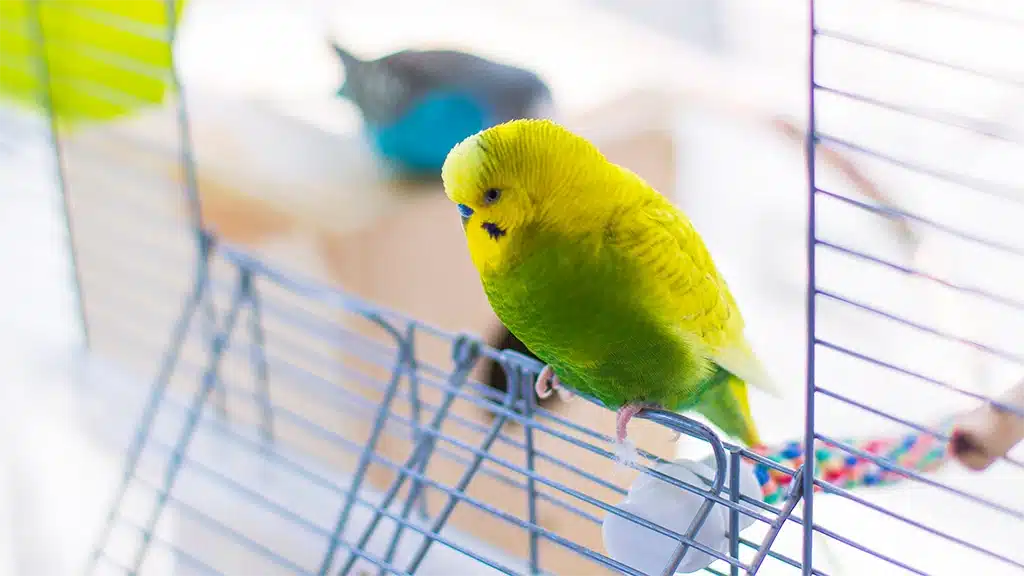
A starving budgie is a big red flag. If you do not take immediate action, the bird might die. But to approach the situation, you must get to the root of this problem.
Generally, a budgie stops eating if they are physically or mentally sick. Runny stool, lethargy, watery eyes, discharge from the mouth, labored breathing, etc., are some symptoms of illness in budgies. Take the bird to a vet if you notice any physical or mental abnormality. With proper treatment, the budgie will be back on its usual routine.
However, a boring diet chart is another reason why the budgie is starving itself. Bring variety to the diet and introduce more items to make the meals exciting and delicious.
Sometimes, budgies accustomed to a seed diet avoid pellet meals. Little Critters Veterinary Hospital suggests offering the birds millet sprays to boost their appetite.
Finally, it is very normal for a new budgie not to eat because of the change in the environment. You have to be cooperative in this scenario and make the bird comfortable in the new home.
Cover the sides of the cage so that the budgie feels secure. Also, spend hours talking to the bird to build a bond. Normally, a newly-welcomed budgie starts opening up and eating within a day or two.
What Human Food Can Budgies Eat?
Budgies can eat human foods in small quantities like apples, bananas, strawberries, watermelon, oranges, mangoes, carrots, cucumbers, and more. They can also eat cooked eggs, pasta, and rice.
Just make sure you don’t give them toxic foods that I discussed earlier.
When it comes to processed human foods, it’s an obvious NO. Because these are often loaded with salts, sugars, and other additives that can be harmful to a budgie’s health.
So, keep the chips and cookies for yourself, and stick to what’s fresh and unprocessed for your budgie.
How Important Is Exercise Along with Diet?
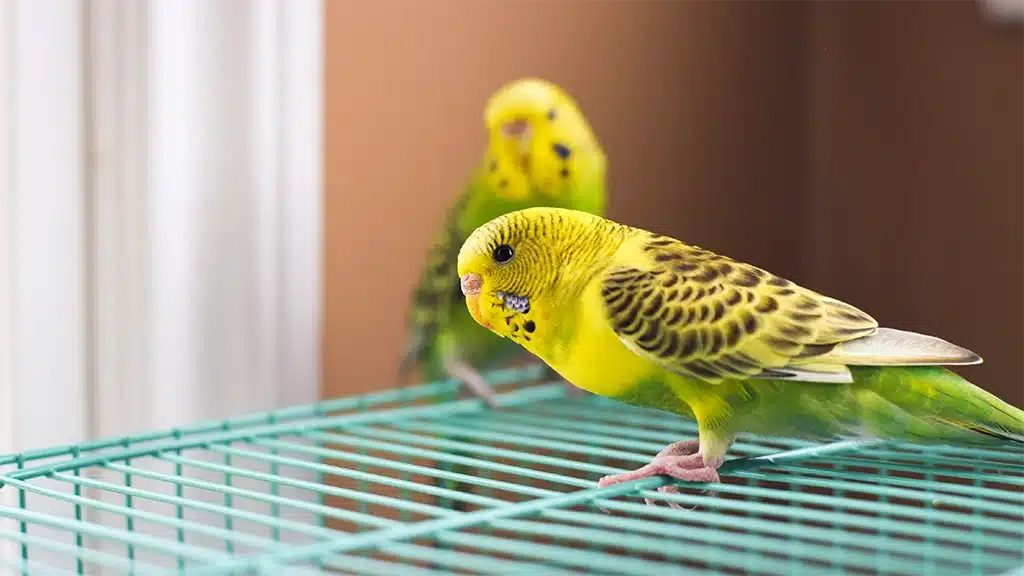
Now you have about 95% idea of what diet should follow for the good health of your budgies. But do you know how important exercise is for them, along with the right food?
Since budgies are active birds they need regular exercise to maintain their overall health and well-being. When I did extensive research I found that, budgies with a balance of good nutrition and regular exercise have better cardiovascular health and more robust immune systems.
So you need to ensure their cage is spacious enough for playing and give them some out-of-cage time so that they can fly freely. Additionally, it’s important to provide a variety of toys that can encourage exercise and keep your budgies engaged.
Here I have attached a video that shows how to exercise your pet bird. Hope it will be helpful for you.
Final Words
Finally, you know a lot about what do budgies eat now! A good diet is important for your budgie’s health. Give them a mix of seeds, high-quality pellets, vegetables, and fruits. Don’t give them too much food because they are small. However, overfeeding can lead to several health problems. Thus, maintaining a balance is very crucial here.
FAQs About Budgie Diet
What Is The Best Diet For A Budgie?
A mix of high-quality pellets, a variety of fresh vegetables, and the occasional fruit treat. Don’t forget to provide fresh water daily and limit seeds to a small portion of their diet.
What Are Budgies Not Allowed To Eat?
Avoid avocado, chocolate, caffeine, alcohol, seeds of fruits, and foods high in fat, salt, and sugar. These can be toxic or harmful for your budgie.
How Much Does A Budgie Eat Per Day?
A budgie typically eats about 1.5-2 teaspoons of seed or pellet mix and 1.5-2 tablespoons of fresh veggies daily. Monitor their weight and adjust as needed.
What Age Do Baby Budgies Eat Seeds?
Baby budgies don’t actually eat seeds themselves until they are a bit older. When a bird is 4-6 weeks old, they start cracking and eating seeds themselves. Sometimes it can take up to 8 weeks.
What Can I Feed My Budgies Other than Seeds?
Seeds are a common starting food for budgies but are often considered unhealthy. Instead of this, you can give them high-quality pellets, fresh fruits and vegetables, leafy greens, and boiled eggs.
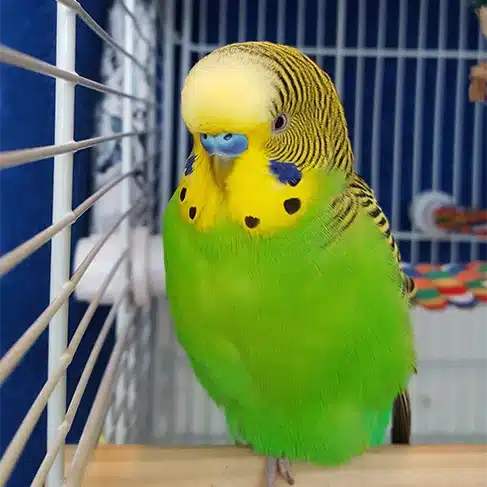
I’m Shajid Rahman, a happy owner of 6 beautiful budgies. I take care of this website to share tips, fun facts, and care guides about these birds.
Whether you’re a budgie lover or considering one as a pet, you’ll find helpful info here! I love these cute creatures, so I made this blog for Budgerigar fans. You can expect to get reliable information based on my years of experience. More About Me →
